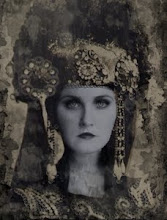

To give you a background regarding the piece, I am an apprentice at the Prosopon School of Iconology. I received my bachelors degree at VCU in Communication Arts and Illustration, so here was the end result of my training and education where the two; the secular and religious somewhat collide. My master would throw a fit if he saw this, however.
When I had my solo show on display recently, this specific image has been often misinterpreted as a "Madonna with Child" and this in no form or fashion is correct. To illustrate, the woman wears a tapered head cover and black robes, indicating her position as an orthodox nun. The fact that she is cradling a precious baby as if it were her own, emerging from an icon modernly suggests the Saint Theodosia of Constantinople who was the patron saint of icons. The baby was purposefully represented as the "every woman's baby" and not baby Jesus, so there are many elements integrated within this one image that are almost always subjugated to misinterpretation. But the purpose is to bring the iconostasis from the church, the wall of information; to a modern and fresh audience. The gallery seems to be the venue for new information and narrative. There are very few existing icons of her, so I took on the task.
Saint Theodosia was an Eastern Orthodox nun, living in a monastery in Constantinople, (Istanbul today). She was witness to the iconoclasm/iconoclastic persecutions during the reign of Emperor Leo III the Isaurian. In 729 Emperor Leo ordered to have all icons in the city removed as well as a specifically significant icon of Christ that stood over the Chalke Gate of the imperial palace. Theodosia was summoned to hide and protect all of the removable icons of her monastery in her room. As the order was about to take place, a group of women surfaced to prevent the removal with Theodosia among the group. Whilst an officer stood on the ladder attempting to remove the icon, Theodosia shook the ladder strongly until the officer fell from it. Unfortunately, the man did die from his injuries. Theodosia was then promptly arrested and brought to a court where she was executed by a ram’s horn through the neck.
Soon after the iconoclasm, Theodosia was then recognised as a martyr and saint of the church. For her fervent efforts and sacrifice of her life, there was a church named for her as well as the sea walls, named the Gate of Hagia Theodosia in the early 1300s in Constantinople, so quite a few centuries after her death. Fortunately, Theodosia is one of the most venerated and revered saints.
As of March 2010, I am currently working on a project of the saints, fables and their iconographic significance into an illustrative series for general public view, rather contemporising the message for the modern audience, with an individual statement for each of course! The others will carry the same style and likewise visual elements.
In summation, my intention was to project a refreshed look to a contemporary mass audience.





